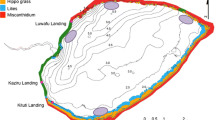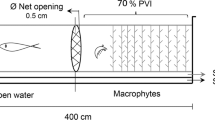Abstract
We determined the associations between Eurasian perch Perca fluviatilis, invertebrates, and common goldeneye Bucephala clangula in boreal lakes. Our aim was to test the hypothesis that perch play a controlling role in small, oligotrophic, acidic, and poorly vegetated boreal lakes, affecting both invertebrate numbers and community structure. In addition, we predicted that perch impact lake usage by goldeneye. In the observational part of our study, we first explored the association between perch, invertebrates and goldeneye (pairs and broods per shore km) in 18 boreal, poorly vegetated lakes. Perch densities were associated negatively with invertebrate abundance and lake usage by goldeneye broods. In the experimental part in three fish-free lakes, we found that upon successful perch introductions, the number and biomass of invertebrates, the proportion of large dytiscids, and lake usage by goldeneye broods significantly decreased. We conclude that perch apparently plays a key role as a predator of invertebrates in boreal lakes with few aquatic macrophytes. It is evident that perch can strongly affect their prey populations and communities, and this predation may have an indirect effect on species, e.g. goldeneye, that consume the same prey.





Similar content being viewed by others
References
Appelberg M, Henrikson B-I, Henrikson L, Svedäng M (1993) Biotic interactions within the littoral community of Swedish forest lakes during acidification. Ambio 22:290–297
Appelberg M, Berger HM, Hesthagen T, Kleiven E, Kurkilahti M, Raitaniemi J, Rask M (1995) Development and intercalibration of methods in Nordic freshwater fish monitoring. Water Air Soil Poll 85:401–406
Bagenal TB, Tesch FW (1978) Age and growth. In: Bagenal TB (ed) Fish production of fresh waters. IBP-Handbook 3. Blackwell Scientific Publications, Oxford, pp 101–136
Batzer DP (1998) Trophic interactions among detritus, benthic midges, and predatory fish in a freshwater marsh. Ecology 79:1688–1698
Batzer DP, Wissinger SA (1996) Ecology of insect communities in nontidal wetlands. Annu Rev Entomol 41:75–100
Batzer DP, Pusateri CR, Vetter R (2000) Impacts of fish predation on marsh invertebrates: direct and indirect effects. Wetlands 20:307–312
Becerra Jurado G, Masterson M, Harrington R, Kelly-Quinn M (2008) Evaluation of sampling methods for macroinvertebrate biodiversity estimation in heavily vegetated ponds. Hydrobiologia 597:97–107. doi:10.1007/s10750-007-9217-8
Bendell BE, McNicol DK (1987) Fish predation, lake acidity and the composition of aquatic insect assemblages. Hydrobiologia 150:193–202
Bond W (2001) Keystone species—Hunting the snark? Science 292:63–64
Carpenter SR, Kitchell JF, Hodgson JR (1985) Cascading trophic interactions and lake productivity. Bioscience 35:634–639
Crowder LB, Cooper WE (1982) Habitat structural complexity and the interaction between bluegills and their prey. Ecology 63:1802–1813
Culler LE, Lamp WO (2009) Selective predation by larval Agabus (Coleoptera: Dytiscidae) on mosquitoes: support for conservation-based mosquito suppression in constructed wetlands. Freshw Biol 54:2003–2014. doi:10.1111/j.1365-2427.2009.02230.x
Diehl S (1992) Fish predation and benthic community structure: the role of omnivory and habitat complexity. Ecology 73:1646–1661
Diehl S, Kornijov R (1997) Influence of submerged macrophytes on trophic interactions among fish and macroinvertebrates. In: Jeppesen E, Sondergaard M, Sondergaard M, Christoffersen K (eds) The structuring role of submerged macrophytes in lakes. Springer, New York, pp 24–46
Eadie JM, Keast A (1982) Do goldeneye and perch compete for food? Oecologia 55:225–230
Elmberg J, Nummi P, Pöysä H, Sjöberg K (1992) Do intruding predators and trap position affect the reliability of catches in activity traps? Hydrobiol 239:187–193
Elmberg J, Nummi P, Pöysä H, Sjöberg K (1993) Factors affecting species number and density of dabbling duck guilds in North Europe. Ecography 16:251–260
Elmberg J, Dessborn L, Englund G (2010) Presence of fish affects lake use and breeding success in ducks. Hydrobiol 641:215–223. doi:10.1007/s10750-009-0085-2
Eriksson MOG (1979) Competition between freshwater fish and goldeneyes Bucephala clangula (L.) for common prey. Oecologia 41:99–107
Eriksson MOG (1983) The role of fish in the selection of lakes by nonpiscivorous ducks: mallard, teal and goldeneye. Wildfowl 34:27–32
Eriksson MOG, Henrikson L, Nilsson B-I, Nyman G, Oscarson HG, Stenson AE, Larsson K (1980) Predator-prey relations important for the biotic changes in acidified lakes. Ambio 9:248–249
European Standard EN 14757 (2005)Water quality—sampling fish with multimesh gillnets. CEN 2005
Evans RA (1989) Response of limnetic insect populations of two acidic, fishless lakes to liming and brook trout (Salvelinus fontinalis). Can J Fish Aquat Sci 46:342–351
Giles N (1994) Tufted duck (Aythya fuligula) habitat use and brood survival increases after fish removal from gravel pit lakes. Hydrobiol 279(280):387–392
Gilinsky E (1984) The role of fish predation and spatial heterogeneity in determining benthic community structure. Ecology 65:455–468
Haas K, Köhler U, Diehl S, Köhler P, Dietrich S, Holler S, Jaensch A, Niedermaier M, Vilsmeier J (2007) Influence of fish on habitat choice of water birds: a whole system experiment. Ecology 88:2915–2925
Hanson MA, Riggs MR (1995) Potential effects of fish predation on wetland invertebrates: a comparison of wetlands with and without fathead minnows. Wetlands 15:167–175
Heck KL Jr, Crowder LB (1990) Habitat structure and predator-prey interactions in vegetated aquatic systems. In: Bell SS, McCoy ED, Mushinsky HR (eds) Habitat structure. The physical arrangement of objects in space. Chapman and Hall, London, pp 281–299
Hunter ML Jr, Jones JJ, Gibbs KE, Moring JR (1986) Duckling responses to lake acidification: do black ducks and fish compete? Oikos 47:26–32
Hyvönen T, Nummi P (2000) Activity traps and the corer: complementary methods for sampling aquatic invertebrates. Hydrobiol 432:121–125
Jeppesen E, Jensen JP, Søndergaard M, Lauridsen T, Landkildehus F (2000) Trophic structure, species richness and biodiversity in Danish lakes: changes along a phosphorus gradient. Freshw Biol 45:201–218. doi:10.1046/j.1365-2427.2000.00675.x
Lappalainen A, Rask M, Vuorinen J (1988) Acidification affects the perch Perca fluviatilis L., populations in small lakes of southern Finland. Env Biol Fishes 21:231–239
McNicol DK, Bendell BE, Ross RK (1987a) Studies on the effects of acidification on aquatic wildlife in Canada: waterfowl and trophic relationships in small lakes in northern Ontario. Can Wildl Serv Occ Pap 62
McNicol DK, Bendell BE, McAuley DG (1987b) Avian trophic relationships and wetland acidity. Trans N Am Wildl Nat Res Conf 52:619–627
Morin PJ (1984) The impact on fish exclusion on the abundance and species composition of larval odonates: results of short-term experiments in a North Carolina farm pond. Ecology 65:53–60
Murkin HR, Abbot PG, Kadlec JA (1983) Comparison of activity traps and sweep nets for sampling nektonic invertebrates in wetlands. Fresh Invert Biol 2:99–106
Nudds TD, Bowlby JN (1984) Predator-prey size relationships in North American dabbling ducks. Can J Zool 62:2002–2008
Nummi P, Pöysä H (1993) Habitat association of ducks during different phases of the breeding season. Ecography 16:319–328
Nummi P, Väänänen V-M, Malinen J (2006) Alien grazing: indirect effects of muskrat on invertebrates. Biol Inv 8:993–999. doi:10.1007/s10530-1197-x
Nyberg K, Raitaniemi J, Rask M, Mannio J, Vuorenmaa J (1995) What can perch population data tell us about the acidifi-cation history of a lake? Water Air Soil Poll 85:395–400
Nyberg K, Vuorenmaa J, Tammi J, Nummi P, Väänänen V-M, Mannio J, Rask M (2010) Re-establishment of perch in three lakes recovering from acidification: rapid growth associated with abundant food resources. Bor Env Res 15:480–490
Olin M, Rask M, Ruuhijärvi J, Kurkilahti M, Ala-Opas P, Ylönen O (2002) Fish community structure in meso- and eutrophic lakes of southern Finland: the relative abundances of percids and cyprinids along a trophic gradient. J Fish Biol 60:593–612
Paasivaara A, Pöysä H (2004) Mortality of common goldeneye (Bucephala clangula) in relation to predation risk by northern pike (Esox lucius). Ann Zool Fennici 41:513–523
Parker GR, Petrie MJ, Sears DT (1992) Waterfowl distribution relative to wetland acidity. J Wildl Manage 56:268–274
Pätilä A (1986) Survey of acidification by airborne pollutants in 52 lakes in southern Finland. Aqua Fennica 16:203–210
Peura P (1990) Happamoituminen Pohjois-Espoon järvissä. Espoon ympäristönsuojelulautakunnan julkaisu 5/90 (in Finnish)
Power ME, Tilman D, Estes JA, Menge BA, Bond WJ, Mills LS, Daily G, Castilla JC, Lubchenco J, Paine RT (1996) Challenges in the quest for keystones. Bioscience 46:609–620
Pöysä H, Rask M, Nummi P (1994) Acidification and ecological interactions at higher trophic levels in small forest lakes: the perch and the common goldeneye. Ann Zool Fennici 31:317–404
Raitaniemi J, Rask M, Vuorinen PJ (1988) The growth of perch (Perca fluviatilis) in small Finnish lakes at different stages of acidification. Ann Zool Fennici 25:209–219
Rask M, Mannio J, Forsius M, Posch M, Vuorinen PJ (1995) How many fish populations in Finland are affected by acid precipitation. Env Biol Fishes 42:51–63
Rask M, Pöysä H, Nummi P, Karppinen C (2001) Recovery of the perch (Perca fluviatilis) in an acidified lake and subsequent responses in macroinvertebrates and the goldeneye (Bucephala clangula). Water, Air, Soil Poll 130:1367–1372
Rask M, Olin M, Ruuhijärvi J (2010) Fish-based assessment of ecological status of Finnish lakes loaded by diffuse nutrient pollution from agriculture. Fish Manage Ecol 17:126–133. doi:10.1111/j.1365-2400.2009.00685.x
Resetarits WJ Jr (2001) Colonization under threat of predation: avoidance of fish by an aquatic beetle, Tropisternus lateralis (Coleoptera: Hydrophilidae). Oecologia 129:155–160. doi:10.1007/s004420100704
Ritchie EG, Johnson CN (2009) Predator interactions, mesopredator release and biodiversity conservation. Ecol Lett 12:982–998. doi:10.1111/j.1461-0248.2009.01347.x
Tammi J, Appelberg M, Beier U, Hesthagen T, Lappalainen A, Rask M (2003) Fish status of Nordic lakes: effects of acidification, eutrophication and stocking activity on present fish species composition. Ambio 32:98–105
Tammi J, Rask M, Vuorenmaa J, Lappalainen A, Vesala S (2004) Population responses of perch (Perca fluviatilis) and roach (Rutilus rutilus) to recovery from acidification in small Finnish lakes. Hydrobiologia 528:107–122
Thorpe JE (1977) Morphology, physiology, behaviour, and ecology of Perca fluviatilis L. and Perca flavescens Mitchell. J Fish Res Board Can 34:1504–1514
Tolonen K, Jaakkola T (1983) History of lake acidification and air pollution studied in sediments in south Finland. Ann Bot Fennici 20:57–78
Tome MW (1988) Optimal foraging: food patch depletion by ruddy ducks. Oecologia 76:27–36
Tonn WM, Magnuson JJ, Rask M, Toivonen J (1990) Intercontinental comparison of small-lake fish assemblages: the balance between local and regional processes. Am Nat 136:345–375
Vuorenmaa J (2007) Recovery responses of acidified Finnish lakes under declining acid deposition. Monogr Bor Env Res 30, Finnish Environment Institute, Helsinki
Welborn GA, Skelly DK, Werner EE (1996) Mechanisms creating community structure across a freshwater habitat gradient. Ann Rev Ecol Syst 27:337–363
Acknowledgments
Jani Pellikka, Hannu Pöysä and two anonymous referees provided valuable comments on the manuscript, James Thompson kindly checked the language, and Esa Pienmunne helped us in the fieldwork.
Author information
Authors and Affiliations
Corresponding author
Rights and permissions
About this article
Cite this article
Nummi, P., Väänänen, VM., Rask, M. et al. Competitive effects of fish in structurally simple habitats: perch, invertebrates, and goldeneye in small boreal lakes. Aquat Sci 74, 343–350 (2012). https://doi.org/10.1007/s00027-011-0225-4
Received:
Accepted:
Published:
Issue Date:
DOI: https://doi.org/10.1007/s00027-011-0225-4




